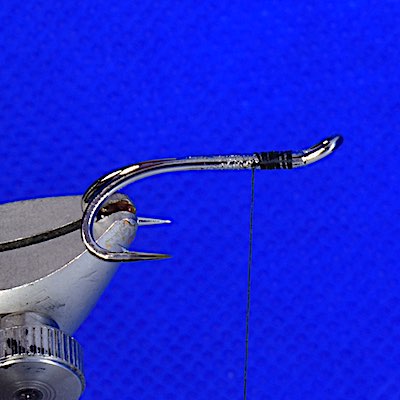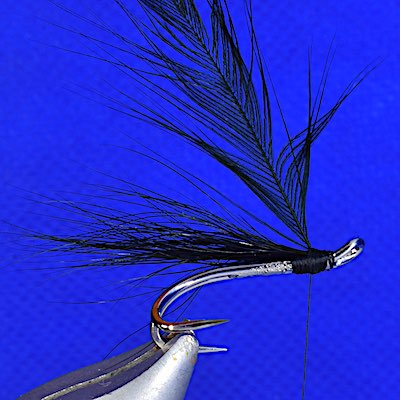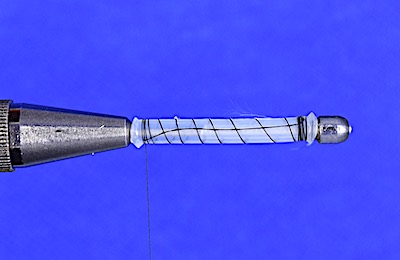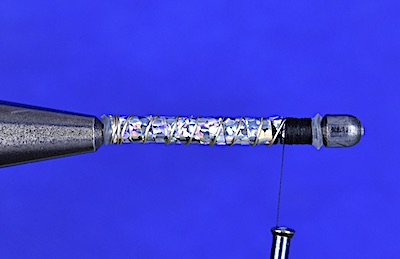If only allowed to take one fly, I suspect most sea trout anglers would select a…
Silver Stoats Tail fly or variation of
Because, since its invention, it’s probably caught more sea trout than any other fly pattern and fooled many Atlantic salmon as a bonus.
I know, if I’m in any doubt over which sea trout fly to select, I invariably start by tying one on and see how it goes.
Adding to its appeal is that it’s simple to tie…
How to tie the Silver Stoats Tail fly
Single, double, and treble hooks and tubes can be used to tie this sea trout fly. However, my preference is to tie it on silver double hooks and tubes (plastic, aluminium, and occasionally copper).
Fly tying material list silver double hook version:
- Hook – Silver Partridge Nordic double (size 10 to 14)
- Thread – Black 8/0
- Body – Silver hook left bare
- Wing – Stoats tail (or black squirrel tail)
- Hackle – Black cock
- Eyes – Jungle cock feathers
This fly is traditionally tied with a Stoat’s Tail wing. However, a black squirrel tail is an acceptable substitute.
Step-by-step fly tying instructions:

Step 1. Place the hook firmly in the vice and start the thread near the eye. Wind it down the hook about 5mm to form a thread base for the wing.

Step 2. Take a small bunch of stoat tail fibres and tie them in so that their tips protrude over the bend of the hook.

Step 3. Select a black cock feather that has fibres about as long as the fly body. Trim the butt section of the feather and tie it in.

Step 4. Make 3 turns of the feather around the hook to form the hackle, tie off, and trim the waste.

Step 5. For the final stage, prepare and tie in a jungle cock feather on either side of the wing. Trim off the waste, whip finish, and varnish the head.
When tying a silver Stoats tail fly on a non-silver hook, it is necessary to form a body using silver tinsel and a silver wire rib. As shown in the tying of the following tube fly version.
Fly tying material list for the tube fly version:
- Tube – Plastic, aluminium, copper Slipstream tubes (size 1/2″ to 3″)
- Thread – Black 8/0
- Body – Holographic tinsel
- Rib – Silver wire
- Wing – Stoats tail (or black squirrel tail)
- Hackle – Arctic fox tail
- Eyes – Jungle cock feathers
Step-by-step tube fly tying instructions:

Step 1. Secure the plastic tube firmly in the vice and add a drop of super glue to the tube. Start the thread near the eye and wind it down the tube in open turns.

Step 2. Marry up the ends of the silver wire and holographic silver tinsel and tie in 3 mm from the head of the tube.

Step 3. Apply a thin layer of super glue to the tube. Then wind the tinsel in touching turns to the head of the tube. Make 3 touching turns of the silver wire at the base of the tube to form a tag. Then wind it to the head of the tube in open turns and tie it off.

Step 4. Take a small bunch of stoat tail fibres and tie them in so that their tips extend to where the hook will finish.

Step 5. Take a small bunch of Artic fox hair and tie it in on the underside of the tube to form a false hackle.

Step 6. Take a pair of Jungle cock feathers and tie them on either side of the wing. Finally, whip finish and varnish the head.
How to fish the Silver Stoats Tail fly
I’ve lost count of the number of sea trout I’ve caught fishing a silver stoats tail fly at night. Also, it has fooled a few Atlantic salmon when fishing for sea trout during the day on a clearing spate.
Sea trout fishing at night
More often than not, I opt to fish a silver stoats tube fly at night because I’ve found sea trout seem to prefer a fly with a longer profile at night.
Equipment-wise, I use a Greys GR80 10ft 7# single-handed rod loaded with a floating line tipped 9ft of 12lbs copolymer, with the tube fly attached to the point.
If I need to fish deeper in the water column, I switch to a fluorocarbon leader (ca, 15lbs). Alternatively, a 10ft intermediate or sinking polyleader can be added to the end of the floating line.

Fishing during the day for sea trout
When the river is clearing after a summer spate, I like to fish the double hook version (size 8 or 10) because it seems to produce better results.
Equipment-wise I use an Orvis Clearwater 11ft 7# switch-rod loaded with a floating line tipped with a 15ft intermediate polyleader and 6ft fluorocarbon tippet (ca. 15lbs breaking strain).
This set-up gives you extra beef for when…
a salmon takes your silver Stoats Tail.

In clear water, it’s better to use a smaller fly (size 12 to 16) and a lighter fluorocarbon tippet (ca.10lbs).
Finally, I hope this article stimulates you to tie and fish the Silver Stoats tail fly. I know I will be fishing them on the Welsh Dee for sea trout and salmon.

I agree Andrew, that if only allowed 1 fly this would be the go to one. The only difference with the ones I make is that I don’t wrap the Mylar/ tinsel around I let mine flow along side the hook. Thanks.
Hi Peter,
Thanks for the tips on your variation of this classic fly. I will tie some and give them a go on the Dee this season. Cheers, Andrew
Thanks for the advice Andrew .going to give it a go when there’s more water on the Dee . Thanks again
Good luck.